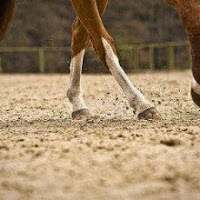We love our farriers, right? But we don’t want to see them all the time. And we sure don’t want to see them for lots of in-between emergency visits to fix random wonky hoof problems that are making our equine friends unhappy. Here are some easy, inexpensive things you can do to keep your horse’s hooves healthy between farrier visits.
Keep moisture balanced
Conditions that are too wet or too dry can play havoc on hooves, especially if those conditions change really rapidly from one to the other. Prolonged exposure to wetness will soften a hoof and cause it to swell. In really dry conditions, the hoof will contract and harden. You can manage this in a few ways:
1. Control the environment by keeping stalls clean and relatively dry and shortening turnout hours when the ground is really wet.
2. Control how much moisture the hoof actually takes in by using a hoof conditioner in dry weather to keep the hoof pliable, a sealant if the weather is really wet, or Venice turpentine to keep the soles of your horse’s feet tough in any environment.
Watch the footing
Riding or turnout on stones increases the risk of stone bruises, but exercise on footing that’s excessively hard can damage the structures of the foot in ways that aren’t as obvious as sole bruises. Deep footing can cause a host of problems, as well. Mucky footing can be a breeding ground for thrush. It also makes it harder for your horse to get his front feet out of the way of his back feet, putting him at risk of pulling a shoe clean off.
On the other hand, do ride the animal and turn it out
Daily exercise and turnout are essential to keeping the hoof functioning like it should.
Treat thrush
Thrush is a bacterial condition that develops when the horse stands in mud, manure, or other damp, bacteria-laden environments. If left unchecked, bacteria eat away at the frog and the grooves of the hoof. If you know what it is, you also know how gross it both looks and smells. This condition can lead to serious damage and lameness, but is fortunately easy to treat with simple topical medications available in almost every tack shop and feed store.
Watch for loose shoes
It’s a whole lot easier for the farrier to replace the shoe than to have to rebuild the giant chunk of hoof wall that came out when your horse tore the shoe off. Loose shoes can cause even bigger problems if they shift, or if a loose nail gets lodged someplace it shouldn’t. If you can wiggle it, it’s time to phone the farrier.
Bell boots
In muddy climates, these are essential to prevent your horse from ripping its front shoes off every time it gets turned out. Even if your area is blessed with perfect ground conditions, bell boots can protect the bulbs of the horse’s heel and make sure that in a scuffle, none of his turnout buddies do the job of taking his shoes off for him.
Consider a supplement
Let’s face it. Some horses’ feet are terrible, regardless of how much daily attention you give them. If your steed’s toes are less than ideal, think about putting him on a supplement to keep them healthy. Biotin has been shown to be useful in lots of cases, as has zinc. Keep in mind that because feet grow so slowly, it might take weeks before you start to see a difference and that difference will be at the top.
Pick out the horse’s feet every day
This is the most effective and least expensive way to prevent problems. This is our opportunity to see problems and head them off before they become serious. We can see what the horse’s feet look and feel like normally and identify things like abscesses, punctures and cracks as they occur. Picking out hooves minimizes damage from stones, lessens the chance of thrush and makes it easier for the farrier to hold the horse’s feet, which makes everyone happier.
And should the farrier praise us for the good behaviour of our horses and the great condition their feet are in, so much the better.
by Cindy McMann
image 1: Pixabay; image 2: Sonja Pauen (Creative Commons BY)









